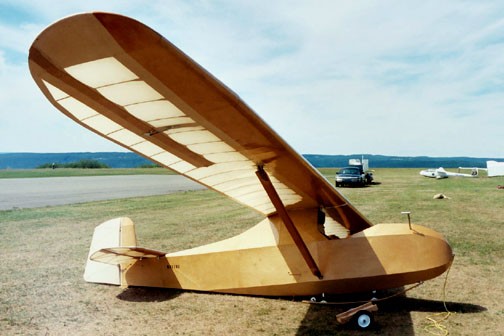Hutter / H-17
Glider Reg. Number: CF-RCD
1934
Design & Development

The Hütter Hü 17, is a German high-wing, strut-braced, single-seat, utility training glider that was designed by brothers Ulrich Hütter and Wolfgang Hütter in the 1930s.
The aircraft's correct designation is unclear and various sources refer to is as the Hütter Hü 17, Hütter-17, Hütter H-17, Hutter H-17, Hütter Hü-17, Göppingen Gö 5 and Goppingen 5.
The Hütter brothers designed the Hü 17 in Salzburg, Austria, in the 1930s, the designation indicating the aircraft's glide ratio. The design was made available as plans for amateur construction and several hundred were completed. Somewhat unusual for its time were the slotted ailerons. The brothers realized that the glider was so light it would never have a lot of wind blowing over its control surfaces and they wanted to enhance control.
The brothers then joined the Schempp-Hirth company which constructed about five of the aircraft under the designation Göppingen Gö 5.
Designed by Austrians, built by Canadians from a British-made kit, registered in Canada, owned by both Canadians and Americans, the Hutter was finally donated to the Museum by the old Soaring Society of Dayton in Ohio. (That club has become the well known Caesar Creek club). So it is a fitting object to represent the international nature of our sport and museum.
The Hutter is a little thing: not quite 10 meters wingtip to wingtip; and light, too, weighing in at a paltry 65 kg empty. There are seat-on-a-plank primary gliders that weigh more. It’s plywood and fabric and very little metal.The aircraft is of wooden construction, using a D-tube wing with a single strut and doped aircraft fabric covering. The wing employs a Göppingen 535 airfoil at the wing root and a NACA M-6 at the wing tip. The fuselage is plywood, covered.
There is not even a windscreen in our pre-War version. As is common with early gliders, the tail feathers are graceful, and the rudder bears the mark “CF-RCD” originally given to it by the Canadian government when they registered it as an ultralight aircraft. That registration belongs to another plan now.
In the 1980s a number of aircraft were still flying in Australia, West Germany, the United Kingdom and the United States. In July 2011 one example was registered with the American Federal Aviation Administration in the Experimental - Exhibition category, having been constructed in 1990.
Specifications
General characteristics
- Crew: one
- Length: 5.18 m (17 ft 0 in)
- Wingspan: 9.96 m (32 ft 8 in)
- Wing area: 9.47 m2 (101.9 sq ft)
- Aspect ratio: 10.5:1
- Airfoil: root: Göttingen 535, tip NACA M-6
- Empty weight: 110 kg (243 lb)
- Max takeoff weight: 210 kg (463 lb)
Performance
- Never exceed speed: 160 km/h (99 mph; 86 kn)
- Aerotow speed: 100 km/h (62.1 mph; 54.0 kn)
- Winch launch speed: 80 km/h (49.7 mph; 43.2 kn)
- Maximum glide ratio: 17:1 at 64 km/h (40 mph)
- Rate of sink: 0.98 m/s (192 ft/min) at 61 km/h (38 mph)
- Wing loading: 22.2 kg/m2 (4.5 lb/sq ft)
Variants
Hü 17
- Initial model with a 9.7 m (31.8 ft) wing span
- Hü 17B
- Improved model, introduced after WWII with increased wing span and higher empty and gross weights
- Göppingen Gö 5
- Model built by Schempp-Hirth